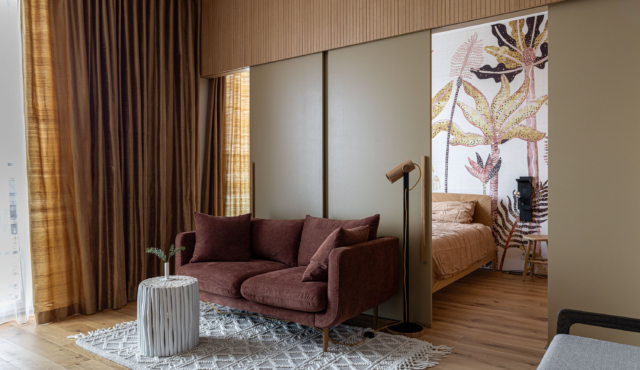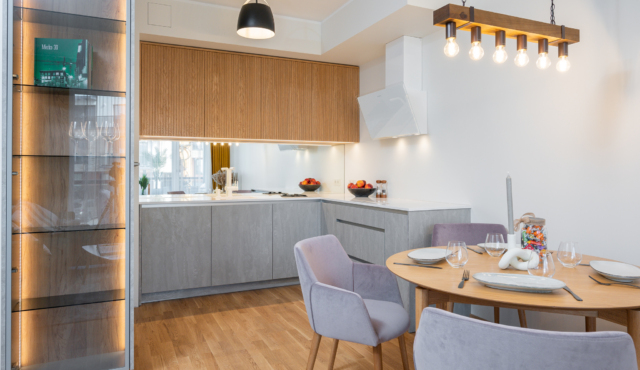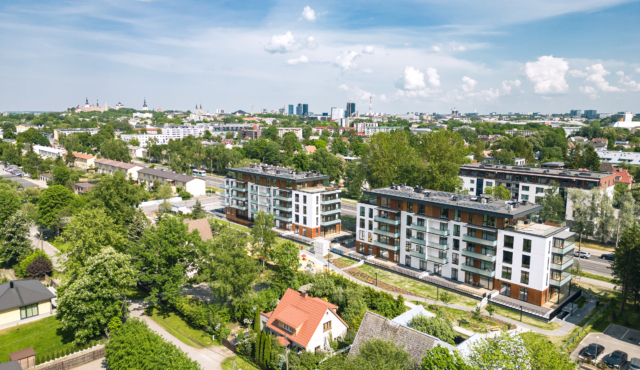How an apartment becomes a home and a development project becomes the living environment?
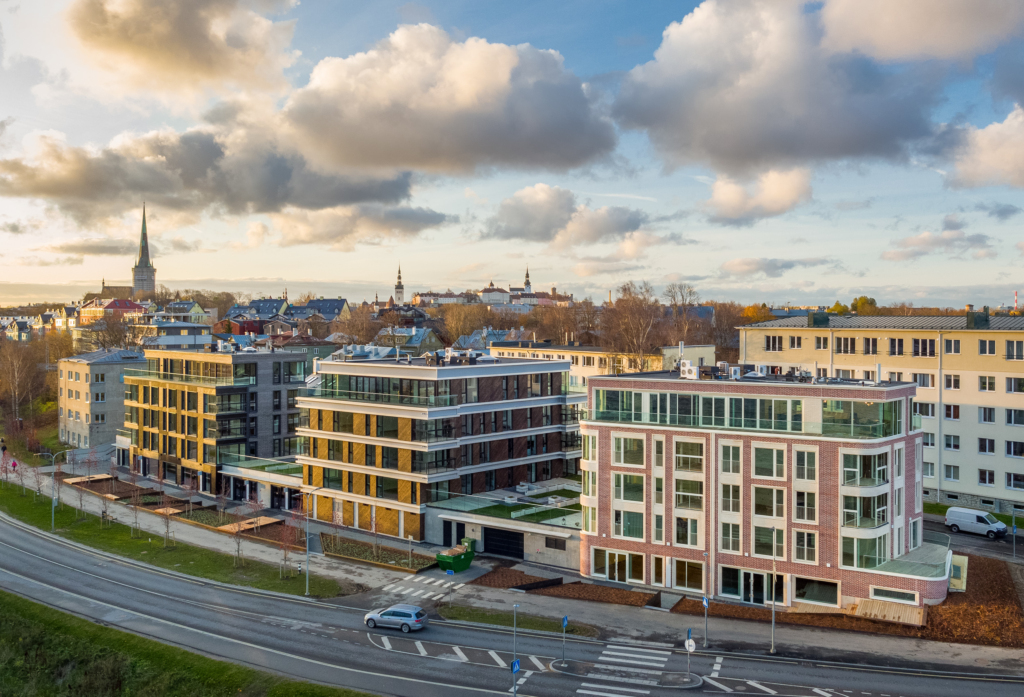
For the third consecutive year, Merko is the best-known and most reputable real estate developer in Estonia based on a Kantar Emor survey of real estate brands. According to the survey, Merko is by far the most strongly associated with qualities such as reliability, top quality, all-round professionalism and contribution to society.
Merko has been the largest apartment seller in Estonia for many years and has now achieved a market share of over 15% in the sale of newly developed apartments in Tallinn. “Merko is doing well, people trust us when buying homes and we are also confident in our customers. We create new residential quarters at tested quality levels, while each new development or construction project is always more innovative and planned in more detail than the previous one,” notes Alar Toomik, who is in charge of the entire Uus-Veerenni project.
Merko’s strength as a developer is not only based on the wisdom gained from the development of thousands of apartments and more than 30 years of construction experience. It is based on the approach and the philosophy that a home is much more than just four walls and a door.
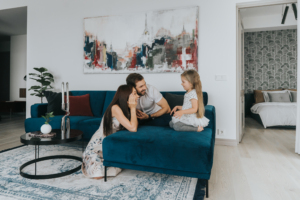
Demonstration apartment from the first stage of the Uus-Veerenni development project. Photo: Paul Meiesaar
How are Merko homes born?
The home starts from the border of the residential quarter and its quality is affected by every little detail both around the home and inside the building and apartment. The layout of the courtyard, the architecture of the building and the interior decoration of the apartment, as well as invisible details, such as the technical system essential for daily well-being, must all be in place.
“We keep an eye on the details and plan for the larger whole. We think in terms of creating a home for a specific family and establish an all-encompassing living environment around that, even entire new districts with street structures, buildings that fit the surroundings and improve the cityscape, and lush green areas that are suitable for the enjoyable use of leisure time or keeping fit. The integration of small businesses, kindergartens and commercial buildings into the whole is no less important,” says Jaan Mäe, Head of Real Estate Development at Merko Ehitus Estonia.
A great example of planning from outside in is Merko’s trendy and extremely successful Uus-Veerenni residential quarter, where the development moved from the district to the quarter, from the residential building to the apartment and then to the rooms and their detailed layout. All of the above elements must be balanced to create a district with a harmonious living environment and meet Merko’s thorough quality standards.
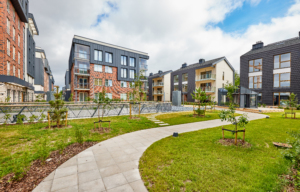
Courtyard from the second stage of the Uus-Veerenni development project. Photo: Tiit Veermäe
What kind of home does Merko offer?
When preparing its development projects, Merko follows principles based on long-term experience, which are constantly evolving to foresee the expectations of a changing society. These principles are broadly divided into five categories:
- Apartment quality – the undisputed focus is on the practical layouts of the apartments; high-quality, tasteful and natural choices in interior decoration; soundproofing of walls and other barriers; Smart Home solutions; electrical solutions that meet the customer’s needs (a sufficient number of electrical outlets in the right places, including on balconies); and provision of cooling.
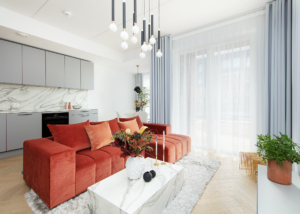
Demonstration apartment from the second stage of the Uus-Veerenni development project. Photo: Katrin Uusoja
- Building quality – we involve the best architects and interior architects in our development projects and we fit our buildings into the surrounding environment. As we are real estate developers and also builders, we do not compromise on construction quality and are extremely careful in the choice of technical systems.
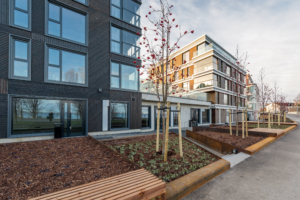
Apartment buildings at Suur-Patarei 20. Photo: Tiit Veermäe
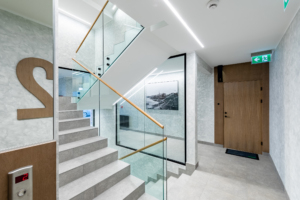
Stairwell of the apartment buildings at Suur-Patarei 20. Photo: Tiit Veermäe
- Quality of the common space – the development of stairwells, parking floors and storage rooms focuses on their functionality and dignified finish. As the needs of homeowners evolve, so do the solutions. Storage rooms with electric scooter charging sockets and bicycle storage, washing and maintenance rooms are increasingly being used. Infrastructure for charging electric cars will also be built.
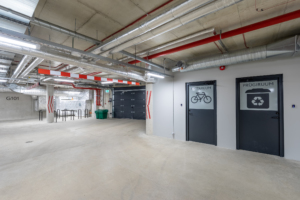
Parking floor of the apartment buildings at Suur-Patarei 20. Photo: Tiit Veermäe
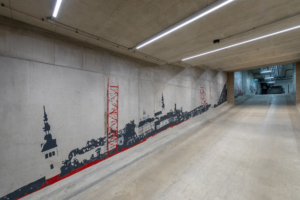
Parking floor of the apartment buildings at Suur-Patarei 20. Photo: Tiit Veermäe
- Quality of the quarter – we involve top landscape architects to develop the environment around the buildings, we establish green areas around the buildings (parks, avenues, courtyards with greenhouses and pergolas), exercise facilities (outdoor gyms, smart solutions encouraging exercise, playgrounds, bicycle racks and maintenance stands), we introduce art (e.g. we supported the erection of a sculpture in Noblessner) and everyday amenities, such as parcel machines, into the living environment.
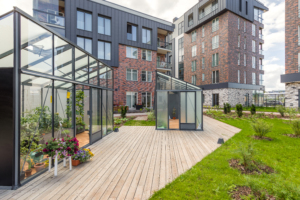
In 2020, the courtyard of the first stage of the Uus-Veerenni development project won the annual award of the Estonian Landscape Architects’ Union in the courtyard category. Photo: Tiit Veermäe
- Quality of urban space – every completed building shapes the cityscape, which is why the buildings we develop and construct must remain dignified for many years to come. We have been supporting the construction of health trails all over Estonia for many years, and we want the paths in our developments to support the same message – regular exercise increases the number of healthy years for those living in Merko homes and also the average Estonian population.

Source: Estonian Health Trails Facebook page
Innovation and innovative thinking are important in Merko’s development projects, which is why we have used various smart and world-class solutions where possible. “For example, the Sustainable Urban Drainage System (SUDS) is used in the courtyards at Uus-Veerenni. We collect rainwater from the roofs and run this through a system of open mini-ditches before excess water flows into the city’s stormwater system. During rainy periods, a lively aqueduct flows through the courtyard, paying homage to history – drinking water was once supplied to the centre of Tallinn by an aqueduct (‘veerenn’) along this very street,” notes Eve Soppe, Sales Manager for Uus-Veerenni.
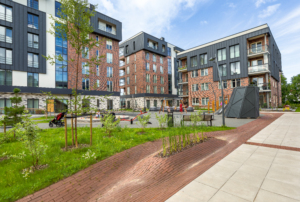
Courtyard from the first stage of the Uus-Veerenni development project. Photo: Tiit Veermäe
Discussion, search and implementation of innovative solutions are regular practices, and this is how each new building and development project at Merko is at least one step ahead of the previous. Much inspiration has been drawn from the best practices of Scandinavian countries and the experience of the more advanced Central European countries, and this will continue.
Merko does not build castles in the sky or make impossible promises. The core value is honesty from the beginning of the project and long-term responsibility to the home buyer. We outline the project, its environment and surroundings as realistically as possible, we use the latest available information and work with the client.
Merko’s goal is to create just the kind of homes that everyone at Merko would themselves like to buy and live in. We know that the modern, knowledgeable customer does not make purchase decisions based on the content of the apartment alone, but also evaluates the planning of the entire development area, the architecture of the buildings, the landscaping of the courtyards, the infrastructure and other aspects.
This and all of the above has created a mutually trusting and satisfying relationship with customers. “This is apparently also the reason why many customers move from one Merko building to the next Merko building when buying a new home,” says Soppe.

